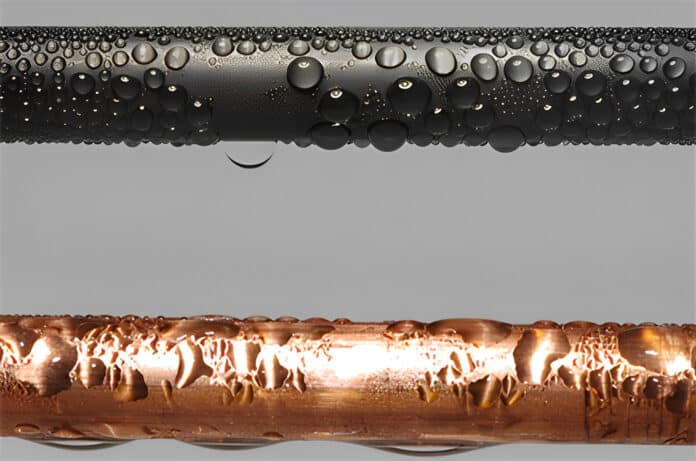Researchers at the University of Illinois Urbana-Champaign have developed a new coating for steam condensers used in fossil fuel steam-cycle generation that could boost the overall process efficiency by 2%.
Worldwide, most of the electricity is generated by steam-cycle power plants, which use either fossil fuel or nuclear fission as the energy source. In the steam cycle, the fuel is burned to boil water; the resulting steam is then channeled to spin a turbine, generating electricity. The steam is then collected in a condenser, which reclaims water from the steam to continue the cycle.
The new coating – made of fluorinated diamond-like carbon (F-DLC), a hydrophobic material – improves the efficiency of the heat transfer of the condenser pipes. The F-DLC coating allows the condensed water to form into droplets rather than a thin film covering the pipe. This puts the steam into direct contact with the condenser pipes and allows heat to be directly transferred.
In tests, the researchers found that the coating improved the heat transfer properties by a factor of 20, which resulted in an overall efficiency boost of 2%. According to their calculations, this efficiency improvement would increase global annual electricity generation by approximately 1000 TWh. This is equivalent to matching 83% of the total electricity produced by all global PV installations with no additional increase in carbon emissions.
Not only that, but the increased efficiency would also reduce CO2 emissions by 460 million tons per year with a decreased use of 2 trillion gallons of cooling water per year.
“It’s remarkable that we can achieve this with F-DLC, something that just uses carbon, fluorene, and a little bit of silicon,” said Muhammad Hoque, a postdoctoral research associate and the study’s lead author. “And it can coat pretty much any common metal, including copper, bronze, aluminum, and titanium.”
In a more than three-year steam condensation experiment, the F-DLC coating demonstrates not only enhanced dropwise condensation heat transfer but also durability in moist environments for this entire length of time. The researchers also found that the coated metals maintained their hydrophobic properties after being scratched 5,000 times in an abrasion test.
Next, the team plans to study the coating’s performance for six months of steady condensation exposure under industrial conditions.
“If all goes well, we hope to show everyone that this is an effective solution that is economically viable,” Miljkovic said in the press release. “We want our solution to be adopted because, although the development of renewable energy should absolutely be a priority, it’s still very worthwhile to continue improving what we have now.”
Journal reference:
- Muhammad Jahidul Hoque, Longnan Li, Jingcheng Ma, Hyeongyun Cha, Soumyadip Sett, Xiao Yan, Kazi Fazle Rabbi, Jin Yao Ho, Siavash Khodakarami, Jason Suwala, Wentao Yang, Omid Mohammadmoradi, Gozde Ozaydin Ince, and Nenad Miljkovic. Ultra-resilient multi-layer fluorinated diamond-like carbon hydrophobic surfaces. Nature Communications, 2023; DOI: 10.1038/s41467-023-40229-6
